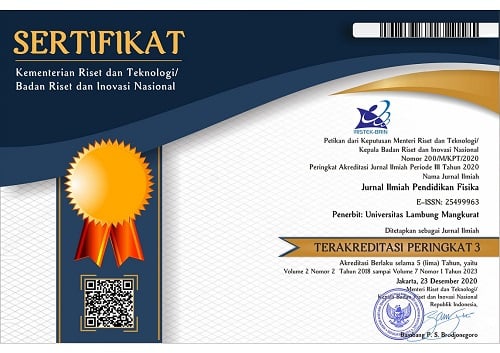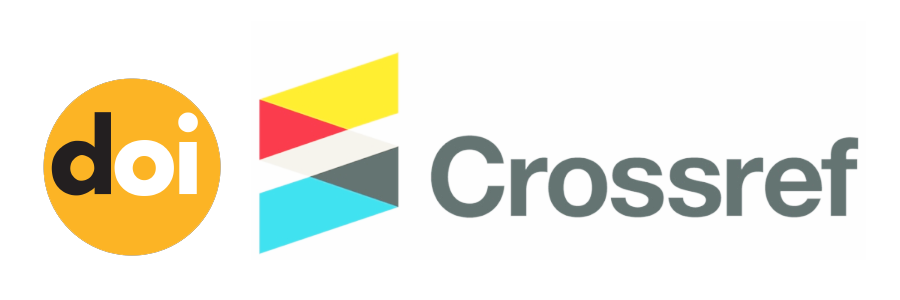Pemahaman Konsep Kecepatan dan Kelajuan Melalui Soal Berbentuk Grafik bagi Calon Guru Biologi
Abstract
Keterampilan pemecahan masalah merupakan salah satu keterampilan penting yang harus dimiliki untuk menghadapi tantangan abad 21. Keterampilan pemecahan masalah membutuhkan pemahaman konsep yang baik. Permasalahan sehari-hari terkait konsep fisika umumnya merupakan permasalahan pada topik kinematika. Permasalahan kinematika tidak hanya disajikan dalam bentuk deskripsi gerak tetapi juga dalam bentuk grafik. Kesulitan dalam memahami konsep dasar mekanika serta kesulitan memahami konsep vektor menyebabkan munculnya berbagai kesulitan dalam menyelesaikan masalah kinematika yang direpresentasikan dalam bentuk grafik. Penelitian ini merupakan penelitian deskriptif dengan metode survei. Tujuan penelitian ini adalah untuk menguji pemahaman konsep kecepatan dan kelajuan mahasiswa menggunakan soal berbentuk grafik. Responden penelitan ini adalah 46 Mahasiswa Pendidikan Biologi FKIP UMRAH. Pengumpulan data menggunakan dua soal essai. Hasil penelitian menunjukkan adanya kesulitan dalam memahami konsep kecepatan dan kelajuan serta merepresentasikan kedua besaran dalam bentuk grafik. Kesulitan disebabkan oleh kurangnya pemahaman konsep kecepatan dan kelajuan serta kurangnya pemahaman konsep vektor. Hal ini mengindikasikan pentingnya pembelajaran kinematika dengan penekanan pada pemahaman konsep melalui penerapan strategi pembelajaran multirepresentasi.
Problem-solving skills are one of the important skills that must be possessed to face the challenges of the 21st century. Problem-solving skills require conceptual understanding. Everyday problems related to physics concepts are generally problems in kinematics. Kinematics problems are not only presented in the form of motion descriptions but also graphical form. Difficulties in understanding the basic concepts of mechanics and the concept of vectors cause various difficulties in solving kinematics problems represented in graphical form. This research was descriptive research with a survey method. The purpose of this study was to test the students' conceptual understanding of velocity and speed using a graphical question. The respondents of this research were 46 Biology Education Students, FKIP UMRAH. The data collection used two essay questions. The results showed difficulties in understanding the concepts of velocity and speed and representing the two quantities in graphical form. A lack of conceptual understanding of velocity and speed and a lack of conceptual understanding of the vector caused difficulties. This indicates the importance of kinematics learning, emphasising understanding the concepts through implementing multi-representation learning strategies.
Keywords
Full Text:
PDFReferences
Barniol, P., & Zavala, G. (2014). Test of understanding of vectors: A reliable multiple-choice vector concept test. Physical Review Special Topics- Physics Education Research, 10(1), 1–14.
Ceuppens, S., Bollen, L., Deprez, J., Dehaene, W., & De Cock, M. (2019). 9th grade students’ understanding and strategies when solving x (t) problems in 1D kinematics and y (x) problems in mathematics. Physical Review Physics Education Research, 15(1), 10101.
Christensen, W. M., & Thompson, J. R. (2012). Investigating graphical representations of slope and derivative without a physics context. Physical Review Special Topics-Physics Education Research, 8(2), 1–5.
De Cock, M. (2012). Representation use and strategy choice in physics problem solving. Physical Review Special Topics - Physics Education Research, 8(2), 1–15.
Docktor, J. L., & Mestre, J. P. (2014). Synthesis of discipline-based education research in physics. Physical Review Special Topics- Physics Education Research, 10(2), 1–58.
Docktor, J. L., Strand, N. E., Mestre, J. P., & Ross, B. H. (2015). Conceptual problem solving in high school physics. Physical Review Special Topics-Physics Education Research, 11(2), 1–13.
Fitri, M., Yuanita, P., & Maimunah, M. (2020). Pengembangan perangkat pembelajaran matematika terintegrasi keterampilan abad 21 melalui penerapan model problem based learning (PBL). Jurnal Gantang, 5(1), 77–85.
Jufriadi, A., Kusairi, S., & Sutopo, S. (2021). Exploration of student’s understanding of distance and displacement concept. Journal of Physics: Conference Series, 1869(1), 0–6.
Laverty, J., & Kortemeyer, G. (2012). Function plot response: A scalable system for teaching kinematics graphs. American Journal of Physics, 80(8), 724–733.
Lichtenberger, A., Wagner, C., Hofer, S. I., Stern, E., & Vaterlaus, A. (2017). Validation and structural analysis of the kinematics concept test. Physical Review Physics Education Research, 13(1), 1–13.
Maemanah, S., Suryaningsih, S., & Yunita, L. (2019). Kemampuan pemecahan masalah melalui model flipped classroom pada pembelajaran kimia abad ke 21. Orbital: Jurnal Pendidikan Kimia, 3(2), 143–154.
Maries, A., & Singh, C. (2013). Exploring one aspect of pedagogical content knowledge of teaching assistants using the test of understanding graphs in kinematics. Physical Review Special Topics- Physics Education Research, 9(2), 1–14.
Meika, I., & Sujana, A. (2017). Kemampuan berpikir kreatif dan pemecahan masalah matematis siswa SMA. Jurnal Penelitian Dan Pembelajaran Matematika, 10(2), 8–13.
Meltzer, D. E. (2005). Relation between students’ problem-solving performance and representational format. American Journal of Physics, 73(5), 463–478.
Planinic, M., Ivanjek, L., Susac, A., & Milin-Sipus, Z. (2013). Comparison of university students’ understanding of graphs in different contexts. Physical Review Special Topics- Physics Education Research, 9(2), 1–9.
Riani, V. R., Sa’Diyah, L. H., Purwanto, M. G., Ramalis, T. R., & Samsudin, A. (2021). Assessing graph interpretation of high school students: An examination by students’ gender. Journal of Physics: Conference Series, 1806(1), 1–7.
Rosenblatt, R., & Heckler, A. F. (2011). Systematic study of student understanding of the relationships between the directions of force, velocity, and acceleration in one dimension. Physical Review Special Topics - Physics Education Research, 7(2), 1–20.
Sarkity, D., Azhar, A., & Sundari, P. (2022). Students‘ ability to identify the types of motion of objects through kinematics graphs. International Conference on Maritime Education (ICOME ) 2021, 134–141.
Sarkity, D., & Permana P, N. Di. (2020). Kemampuan pemecahan masalah sarjana pendidikan fisika pada topik dinamika rotasi. Jurnal Riset Fisika Edukasi Dan Sains (Jrfes), 7(2), 75–86.
Sarkity, D., & Sundari, P. D. (2020a). Pemahaman konsep fisika calon guru biologi pada topik kinematika. Pedagogi Hayati: Jurnal Ilmiah Pendidikan Biologi, 4(2), 106–116.
Sarkity, D., & Sundari, P. D. (2020b). The ability of junior high school science teacher in solving the problems of torque. Jurnal Geliga Sains: Jurnal Pendidikan Fisika, 8(2), 73.
Sarkity, D., Yuliati, L., & Hidayat, A. (2016). Kesulitan siswa SMA dalam memecahkan masalah kesetimbangan dan dinamika rotasi. In Prosiding Semnas Pendidikan IPA Pascasarjana UM, 1(1), 166–173.
Shaffer, P. S., & McDermott, L. C. (2005). A research-based approach to improving student understanding of the vector nature of kinematical concepts. American Journal of Physics, 73(10), 921–931.
Shodiqin, M. I., & Taqwa, M. R. A. (2021). Identification of student difficulties in understanding kinematics : focus of study on the topic of acceleration. Journal of Physics: Conference Series, 1918, 1–5.
Subali, B., Rusdiana, D., Firman, H., & Kaniawati, I. (2015). Analisis kemampuan interpretasi grafik kinematika pada mahasiswa calon guru fisika. Prosiding Simposium Nasional Inovasi Dan Pembelajaran Sains 2015 (SNIPS 2015), 2015(Snips), 269–272.
Sutopo, S., Parno, P., & Angin, S. L. (2017). Pemahaman mahasiswa tentang multi representasi konsep percepatan. Jurnal Riset dan Kajian Pendidikan Fisika, 4(2), 48-53.
Syuhendri, S. (2021). Effect of conceptual change texts on physics education students’ conceptual understanding in kinematics. Journal of Physics: Conference Series, 1876(1), 0–8.
Taqwa, M. R. A., Hidayat, A., & Sutopo, S. (2017). Konsistensi pemahaman konsep kecepatan dalam berbagai representasi. Jurnal Riset dan Kajian Pendidikan Fisika, 4(1), 31.
Yildiz, A. (2016). A discussion on velocity-speed and their instruction. Journal of Physics: Conference Series, 707(1).
Yuberti, Y., Saregar, A., Latifah, S., Anugrah, A., Misbah, M., & Jermsittiparsert, K. (2021). Approaching the problem-solving skills of momentum and impuls phenomena using context and problem-based learning. (European Journal of Educational Research, 8(4), 1217-1227.
Zainuddin, A., Kusairi, S., & Zulaikah, S. (2019). Kesulitan mahasiswa dalam memahami konsep kinematika gerak 1 dimensi. Jurnal Pendidikan: Teori, Penelitian, Dan Pengembangan, 4(1), 56–60.
Zubaidah, S. (2016). Keterampilan abad ke-21: keterampilan yang diajarkan melalui pembelajaran. Seminar Nasional Pendidikan Dengan Tema “Isu-Isu Strategis Pembelajaran MIPA Abad 21, Desember, 1–17.
DOI: https://doi.org/10.20527/jipf.v6i3.5467
Refbacks
- There are currently no refbacks.
Indexed by: Jurnal Ilmiah Pendidikan Fisika is licensed under a creative commons attribution-share alike 4.0 international license
Statistics Counter |
















